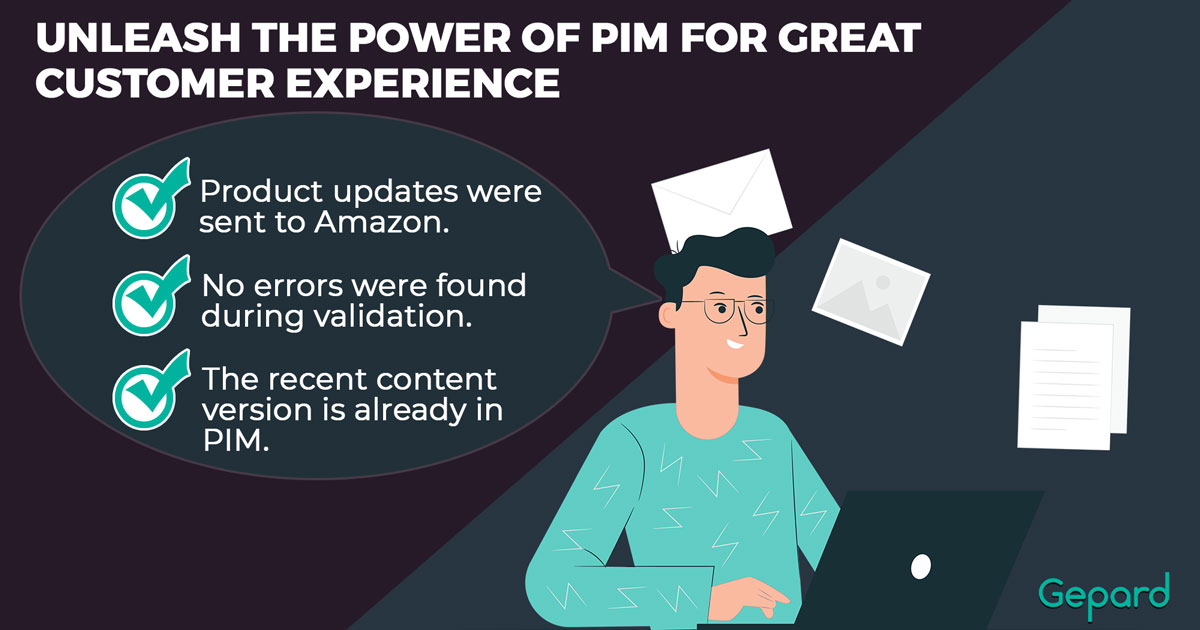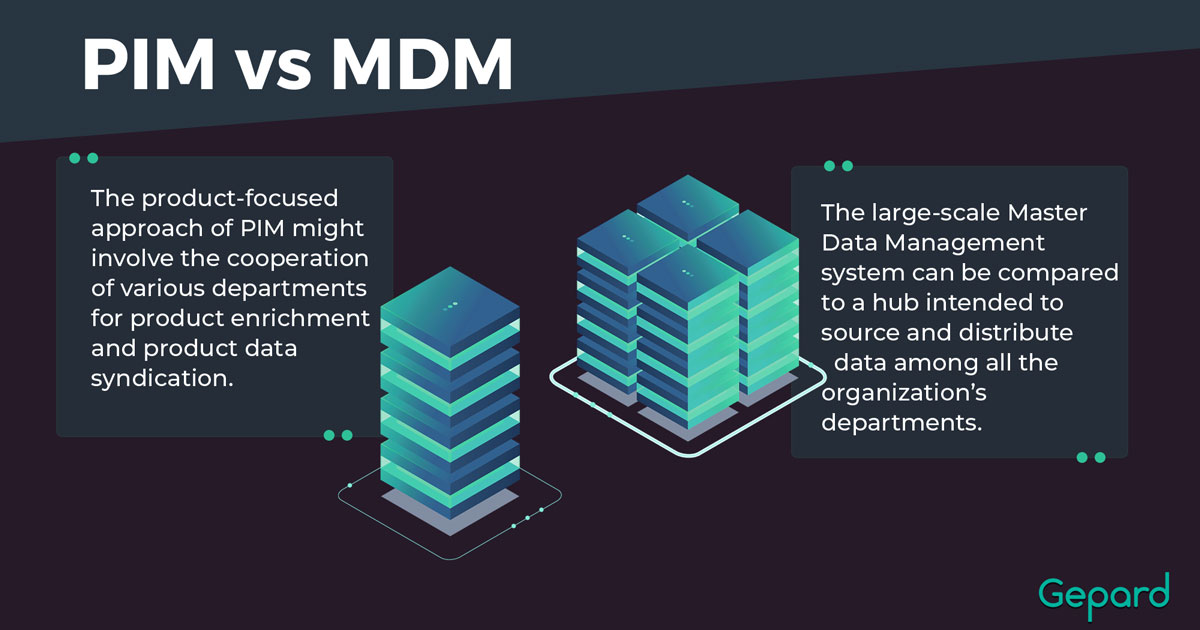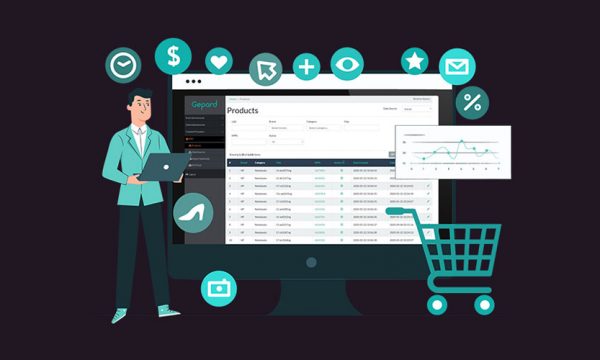PIM Solution: What Will My Company Gain While Using It?
eCommerce leaders implement PIM systems to improve data-related processes within an organization, enhance the company’s performance and deliver an outstanding customer experience. If your company has not chosen a PIM product yet, here are some solid reasons why you should do it ASAP.
- Become aligned with all distribution channels
The product information management tool adjusts your product content in line with the retailer’s needs and allows you to distribute product data faster and speed up time to market. PIM ensures that your data is delivered to the various marketplaces in the right format and required template.
- Set up automated content delivery to retailers
A well-developed PIM system usually has an advanced in-built product content syndication module that allows you to seamlessly adjust your product content to retailers’ data model and automatically push it to external sales channels. Actually, it works the same in the reverse order. ?Retailers can also optimize their collaboration with suppliers and automatically adjust the external data structure to their own requirements.
- Obtain error-free product content
With the help of advanced data validation tools, it is possible now to automatically identify product content inconsistencies, improve the data gaps, and control the content quality which is published on various sales channels.
- Get the enhanced customer experience
In eCommerce, the PIM solution helps you organize your product content understandably and efficiently. It increases the chances of delivering the right product data to the right person at the right time, which facilitates product search and keeps customers satisfied. The solution also serves you when creating compelling rich product content to attract more buyers. Constantly updated and accurate product data creates an excellent customer experience and helps you to build brand loyalty and trust.
- Keep your team informed
Having a PIM system as a single point of truth keeps your team members well-informed and prevents data-related misunderstandings in a company. PIM keeps the chances of data errors to a minimum and enables everyone in the company to use the same data for work, which makes the process of making business decisions more effective.
Product Information Management eCommerce Benefits
eCommerce businesses make the most of using the PIM product: it benefits operations efficiency, sales and improves the experience of both team members and customers.
1. Expand sales channels easily
For eСommerce businesses that want to operate on multiple sales channels, PIM solution helps to seamlessly deliver product data to different marketplaces and locales and handle multi-channel marketing, which increases the chances of making a purchase. It also gives the benefit of improved collaboration with the suppliers: you have a full outline of product locations, supplies, delivery information, inventories, and write-offs. What is more important, is that with Gepard PIM you can easily connect to new sales partners in a single week.
2. Boost productivity
Product information management systems automate many data-related processes, eliminate human errors as well as improve data quality. You get a wide range of tools to edit, enrich and deliver product information automatically and save your team members from monotonous manual tasks. Increase employees’ productivity by 75%, as the team members can focus on strategic tasks that add more innovations and value to your business.
3. Increase ROI
PIM can scale up your company’s ROI as it significantly speeds up product launches, delivers your product information adjusted to a variety of marketplaces, and results in sales growth. The accurate and quality product content reduces the percentage of product returns and builds loyalty and trust, which means more repeat sales for your business and an increase in ROI.

PIM system, DAM or MDM: What to Choose
The market offers businesses a lot of software solutions for managing product information. They are tailored for businesses of different kinds and scales.
PIM vs DAM
DAM (Digital Assets Management) products handle a wide range of digital information, owned by a company. DAM suits organizations that operate a big number of digital assets that are frequently created, edited, and shared between company members with different workflows. Meanwhile, PIM systems fit well for businesses with complex and constantly updated product portfolios, dynamic product ranges, and multi-channel marketing.

PIM vs MDM
MDM (Master Data Management) system holds all the company’s data, while PIM is designed to take care of product information and serves as a powerful sales & marketing tool for businesses. MDM works great for businesses that want to organize all the applicable back-end information and improve data control. PIM offers more opportunities for selling on multiple channels, improving product content, expanding business, and boosting its performance.

You can find out more about these systems in Gepard’s detailed solutions comparison.
How to Choose the Right Product Information Management Solution
The variety of PIM products on the market is constantly growing, which sometimes leads to confusion and difficulties in choosing the right solution.
Required PIM Features
Here are some crucial characteristics of an efficient PIM product:
- Simple integration. Look for a PIM tool that seamlessly integrates with the existing software ecosystem, which helps you optimize product information management processes. The software should have a user-friendly interface, to comfortably onboard even non-technical users.
- Automated product taxonomy mapping. PIM should be able to adjust all the required product content to your business needs. For this purpose, choose the system with intelligent data mapping algorithms.
- Localization possibilities. One of the important PIM features that allow you to expand your business to different locales by offering product information in the local language of your potential customers.
- Product data syndication. Check if the system can automatically deliver product content synchronized across multiple sales platforms while meeting the data requirements of the respective marketplaces.
- Customization (multi-tenancy) opportunities. Search for a PIM with multi-tenant system architecture. It allows all team members to use the core system while at the same time, it can be customized to make the most out of it.
You can also be interested in
PIM Implementation Flexibility
Choosing the proper delivery model is a part of product information management system implementation. Here are the most common types:
- On-premises. You, as the customer, are responsible for the technical infrastructure and the platform, including product information management tools.
- SaaS (Software as a Service). The entire stack is the full responsibility of a third party. In the case of SaaS there’s no coding required from your side, which makes it one of the most popular decisions among PIM customers.
- PaaS (Platform as a service). You, as a customer, are in charge of the application layer, while the third party takes care of infrastructure and platform management.
The choice of system deployment type should be based on business needs, and meet the following requirements:
- The system should be flexible enough for frequent customizations.
- There should be an opportunity to onboard tailor-made connections, beyond the available options.
- Strong support of vendors and suppliers.
- Software costs within your company’s budget.
How GS1 Launched the PIM System for Dutch Fashion Suppliers
PIM Integration Opportunities With Other Systems
When choosing a PIM system, it’s important to consider its data integration options with other systems. Here are some common integration options you should review. In this table, we outline the potential impacts of integrating PIM with various other systems and list some of the best providers in each category.
| System Type | Potential Impact | Best Providers |
| eCommerce Platforms | Streamlined product catalog management, more efficient payment gateway integration, improved order management, better customer data management | Shopify Magento BigCommerce WooCommerce |
| Inventory Management | Improved inventory tracking, reduced stockouts, increased order fulfillment accuracy, better product availability | Zoho Inventory TradeGecko Skubana Orderhive |
| Order Management | Streamlined order processing, improved order accuracy, reduced fulfillment times | Cin7 Skubana Brightpearl Orderhive |
| Customer Relationship | Improved customer engagement, increased customer loyalty, better customer segmentation, more effective product recommendations, streamlined marketing automation | Salesforce Zoho CRM HubSpot SharpSpring |
| Marketing Automation | More efficient marketing campaigns, personalized content delivery, increased customer engagement, and improved customer segmentation | Marketo HubSpot Pardot ActiveCampaign |
| ERP Systems | Streamlined financial management, integrated supply chain management, more accurate inventory management, improved order processing | SAP Oracle NetSuite Microsoft Dynamics Sage |
PIM System Support
While choosing your future PIM provider it’s essential to consider the level of support and resources provided by them. Here are some things you should pay attention to when assessing the level of support and resources provided by the PIM vendor:
- Customer Support. The PIM vendor should provide reliable customer support, including a helpdesk, email, and phone support. It’s crucial to check the vendor’s response time and the quality of the support they provide. Make sure that the vendor has a well-documented process for handling customer issues and that their support team is knowledgeable and experienced.
- Training and Onboarding. The vendor should offer training and onboarding sessions to help you get started with the PIM system. This training should cover all aspects of the system, including data entry, product categorization, and data management. You should also ensure that the vendor offers ongoing training and support as needed.
- Documentation. The PIM vendor should provide comprehensive documentation, including user manuals, tutorials, and other resources. This documentation should be easy to access, navigate and understand.
- Integration and Customization Support. The vendor should provide support for integrating the PIM system with other systems such as eCommerce platforms, ERPs, and CRMs. The vendor should also offer customization services to meet your specific business requirements.
When assessing the level of support and resources provided by a PIM company it’s crucial to consider the vendor’s responsiveness, expertise, and the quality of the resources they provide. By doing so, you can make an informed decision and choose a PIM provider that can help you achieve your business goals.
How to Convince My Company Stakeholders to Integrate PIM?
Before investing in PIM software, the stakeholders should consider how the system can benefit different business processes and learn how it can deliver measurable results.
Download this informative PIM guide for brands to uncover the possibilities of product information management for your business or get the free Ebook that can help you make the reasoned choice of PIM software.
Product Information Management FAQs
How are PIM and headless commerce related?
Headless commerce and PIM can be integrated to provide a seamless flow of accurate and consistent product information across multiple channels and devices. The PIM system centralizes and manages product data, while the headless commerce platform delivers custom eCommerce experiences. By pulling product data from the PIM system, the headless commerce platform ensures that customers have access to up-to-date product information, improving the customer experience and reducing errors. This integration allows for greater flexibility and scalability in creating and delivering custom eCommerce experiences.
What are some key features that I should look for in PIM software for digital commerce?
When looking for PIM software for digital commerce, you should consider that solution should have features including the ability to manage multiple product catalogs for different channels, customization of product data for each channel, integration with other eCommerce platforms and systems, and automation of certain tasks related to product data management. Additionally, businesses should look for PIM software that can scale with their needs and provide analytics and insights to help improve their product offerings and increase sales.
What types of businesses can benefit from using a PIM system?
Product Information Management (PIM) systems can benefit businesses that have large product catalogs and sell across multiple channels, including e-commerce, marketplaces, and physical stores. This includes industries such as retail, manufacturing, distribution, and wholesale. PIM systems help businesses maintain consistent, accurate, and up-to-date product information, improve time-to-market, and enhance customer experience.
What’s Next?
If you are searching for a solution that combines all the essential PIM features, including content syndication, smart interface, and intelligent data mapping, look no further than Gepard.
Make the most out of your PIM data – Book Free Personalized Demo now.




